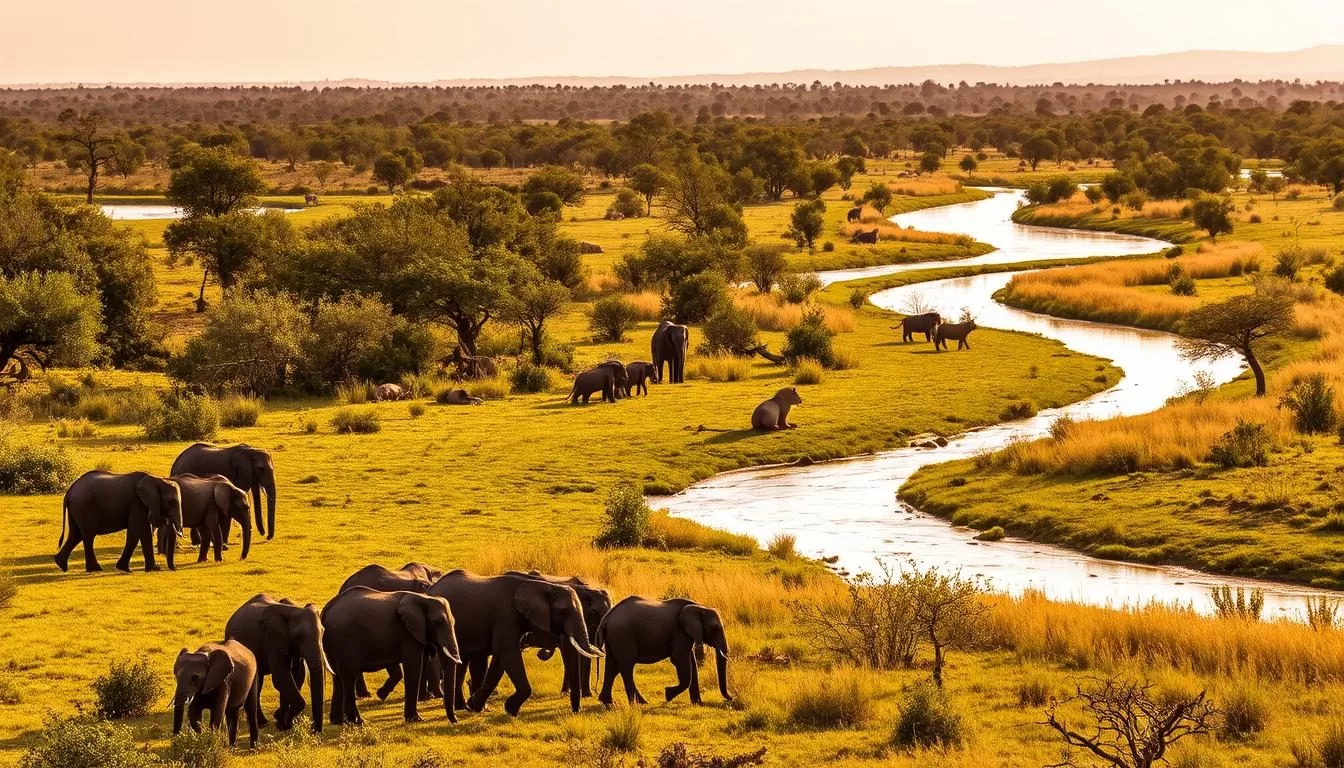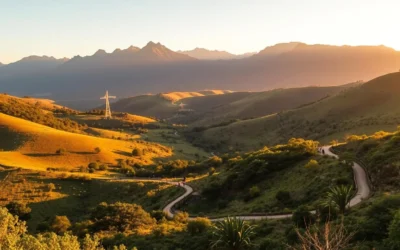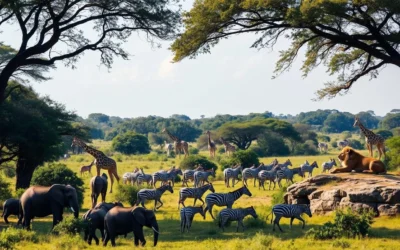✓ Accommodations✓ Flights✓ Rental Cars
Imagine a place where the landscape is dotted with magnificent baobab trees, sandstone formations, and diverse wildlife ranging from elephants to over 400 bird species. Welcome to a destination that offers a unique blend of cultural heritage and natural beauty, making it one of the most distinctive yet underappreciated places in South Africa.
Located at the confluence of the Limpopo and Shashe rivers, this UNESCO World Heritage Site protects the remains of an ancient African kingdom that flourished between 1200 and 1300 AD. As you explore this incredible site, you’ll discover a landscape that is not only breathtaking but also steeped in history and culture.
You can enjoy game drives and spectacular viewpoints, or explore ancient archaeological sites, making for an unforgettable experience.
Discovering Mapungubwe National Park: A Hidden Gem in South Africa
Tucked away in the northernmost part of South Africa, Mapungubwe National Park is a treasure trove of history and natural beauty. This unique destination offers a blend of cultural heritage and wildlife experiences that are sure to captivate any visitor.
Where is Mapungubwe National Park Located?
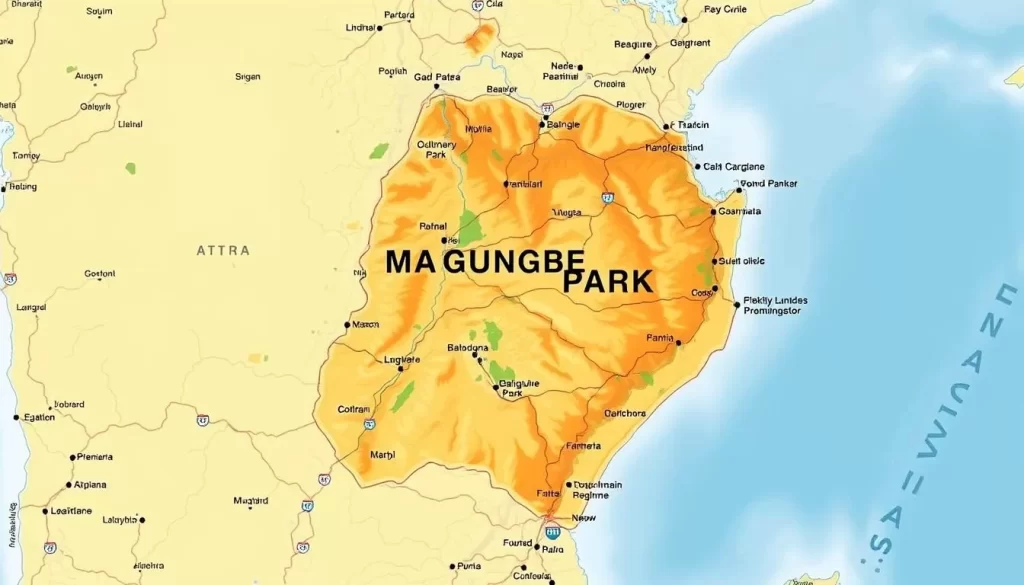
Mapungubwe National Park is located in the Limpopo province of South Africa, near the borders of Botswana and Zimbabwe. This strategic location has contributed to the park’s rich cultural and historical significance.
Why Mapungubwe is a UNESCO World Heritage Site
Mapungubwe was declared a UNESCO World Heritage Site in 2003 due to its archaeological importance. The site provides valuable insights into the lives of the people who inhabited the area over a thousand years ago, showcasing a sophisticated level of urbanization and trade.
Best Time to Visit Mapungubwe National Park
The best time to visit Mapungubwe National Park is during the dry winter season, from May to September. During this period, the weather is mild, with daytime temperatures around 25°C (77°F), making it ideal for outdoor activities and wildlife viewing. In contrast, the summer months can be extremely hot, with temperatures reaching up to 45°C (113°F).
Some key benefits of visiting during the dry winter season include:
- The dry season offers better wildlife viewing opportunities as animals congregate around water sources.
- The reduced vegetation during this time improves visibility, making it easier to spot wildlife.
- The cooler months provide more comfortable conditions for guided walks and exploring archaeological sites.
While the wet season brings migratory bird species to the park, increasing bird diversity, the heat and occasional rainfall may make outdoor activities challenging.
The Cultural Significance of Mapungubwe National Park, South Africa: Best Things to Do – Top Picks
As you visit Mapungubwe National Park, you’ll uncover the layers of its cultural significance, rooted in history and archaeology. The park is home to a wealth of cultural treasures that provide insights into the lives of its ancient inhabitants.
The Ancient Kingdom of Mapungubwe
The ancient kingdom of Mapungubwe was a sophisticated society that thrived in the region over 1,000 years ago. This civilization is notable for its advanced metalworking skills and extensive trade networks. The kingdom’s wealth and social stratification are evident in the archaeological findings, which include gold artifacts and other precious items.
The Golden Rhino and Other Archaeological Treasures
The Golden Rhino of Mapungubwe is one of the park’s most iconic archaeological finds. Discovered in 1932, this small gold foil rhinoceros figurine is about six inches long and symbolizes the remarkable metalworking skills of the ancient civilization. The Mapungubwe museum is home to replicas of this and other artifacts, including a bowl and scepter, which are on display for visitors. 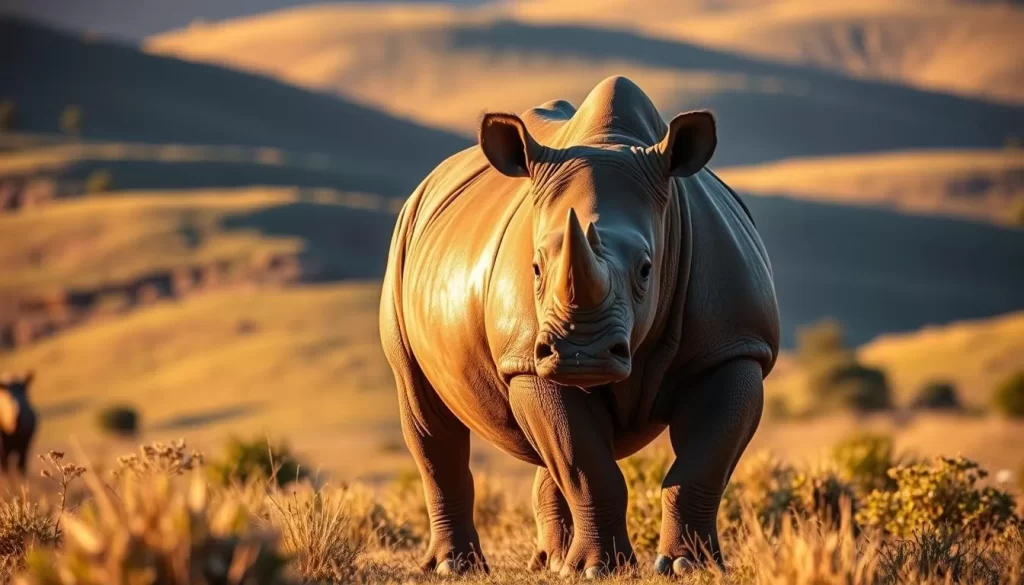
- The Golden Rhino is not only an important archaeological find but also holds profound cultural significance for many South Africans.
- The Mapungubwe Interpretation Centre, with its innovative design, houses replicas of these precious artifacts, blending harmoniously with the surrounding landscape.
- Beyond gold items, archaeologists have uncovered Chinese porcelain, Persian glass beads, and other imported goods, confirming Mapungubwe’s participation in extensive trade networks.
The original Golden Rhino is currently housed at the University of Pretoria, though discussions about its permanent home continue. The museum’s design, consisting of domes made from local sandstone, has won architectural awards for its integration with the natural environment while protecting these cultural treasures.
Exploring Mapungubwe Hill: A Journey Through Time
As you explore Mapungubwe Hill, you’ll embark on a journey through time, uncovering the secrets of this ancient African kingdom. The hill is a significant historical site that offers insights into the lives of the people who once called it home.
The Heritage Walk Tour Experience
The Heritage Walk Tour is an immersive experience that takes you to the summit of Mapungubwe Hill, where you’ll discover the rich history of this ancient place. As you ascend, your guide will share stories about the hill’s significance and the people who lived there.
Upon reaching the top, you’ll be rewarded with breathtaking views of the surrounding landscape, where the borders of three countries meet. The tour provides a unique opportunity to learn about the social stratification of the ancient society, with approximately 50 members of the ruling elite living on the hill, while around 5,000 commoners resided in the valleys below.
What You’ll Discover at the Top
At the summit, you’ll gain a deeper understanding of the historical significance of Mapungubwe Hill. Your guide will point out the archaeological evidence of the royal enclosure, where the king and his family lived between 1220 and 1290 AD. You’ll learn about the strategic importance of the hill, which served as a natural fortress and a symbol of the royal family’s elevated status.
The experience of standing on Mapungubwe Hill, where an ancient African king once ruled, provides a powerful connection to the past. It’s an experience that transcends the typical safari adventure, offering a unique glimpse into the lives of the people who shaped this land.
Wildlife and Nature Experiences in Mapungubwe
The diverse landscapes of Mapungubwe National Park offer a unique blend of wildlife and nature experiences. As you explore this magnificent park, you’ll encounter a wide range of flora and fauna that call Mapungubwe home.
Self-Drive Game Viewing Adventures
Mapungubwe offers an exhilarating self-drive game viewing experience, allowing you to explore the park’s diverse wildlife at your own pace. As you navigate through the park’s scenic routes, keep an eye out for the Big Five and other fascinating creatures that inhabit the area. The self-drive option provides a unique opportunity to connect with nature and enjoy the thrill of spotting wildlife in their natural habitat.
The Magnificent Baobabs of Mapungubwe
The park is renowned for its majestic baobab trees, which dot the landscape and provide a striking contrast to the surrounding savanna. These ancient trees are not only a testament to the region’s rich natural heritage but also offer a unique photographic opportunity. As you explore the park, take a moment to appreciate the majesty of these incredible trees.
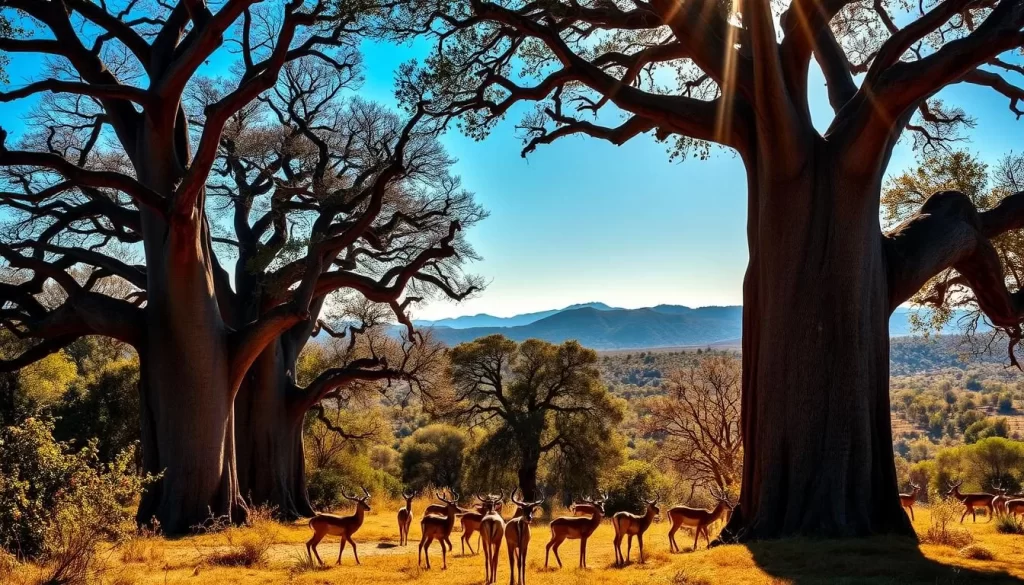
Birding Paradise: 400+ Species to Spot
With over 400 recorded bird species, Mapungubwe is a birdwatcher’s paradise. The park’s diverse habitats, ranging from riverine forests to open savannas, support a wide variety of bird life. The Limpopo Treetop Boardwalk is a particularly popular spot for birding, offering a chance to observe canopy-dwelling bird species up close. During the wet season, migratory birds join the resident species, significantly increasing the diversity of birds you can spot.
| Bird Species | Habitat | Best Time to Spot |
|---|---|---|
| Pel’s Fishing Owl | Riverine Forests | Wet Season |
| Southern Carmine Bee-eater | Open Savannas | Summer Months |
| Meyer’s Parrot | Woodland Areas | Year-Round |
In conclusion, Mapungubwe National Park is a haven for wildlife and nature enthusiasts, offering a range of exciting experiences. From self-drive game viewing adventures to the majestic baobab trees and incredible birding opportunities, there’s something for everyone in this incredible park.
Must-Visit Viewpoints and Walking Trails
As you explore Mapungubwe National Park, you’ll discover an array of must-visit viewpoints and walking trails that showcase the park’s diverse landscapes. These vantage points and pathways offer a unique perspective on the park’s natural beauty and cultural significance.
The Confluence View Deck: Where Three Countries Meet
The Confluence View Deck is a standout attraction in Mapungubwe National Park, offering a panoramic view of the confluence of the Shashe and Limpopo rivers, where South Africa, Zimbabwe, and Botswana meet. This viewpoint is not just a geographical marvel but also a spot for observing wildlife that comes to the rivers to drink.
Treetop Walkway: Walking Among the Fever Trees
The Treetop Walkway in Mapungubwe National Park provides a thrilling experience as you walk among the fever trees, offering a canopy-level perspective of the forest. This elevated walkway allows visitors to observe the park’s flora and fauna from a unique vantage point, enhancing the overall safari experience.
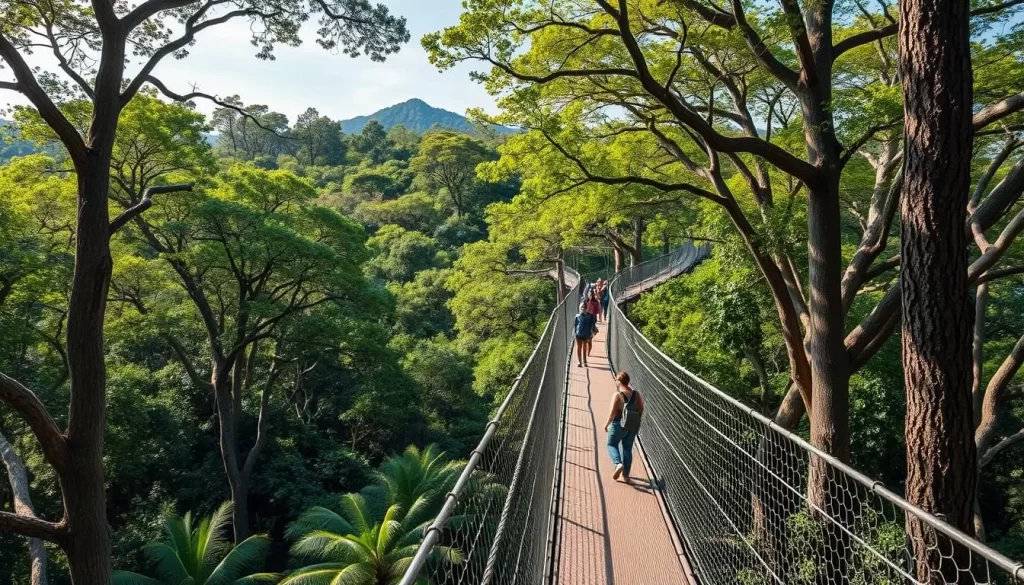
Maloutswa Hide: Prime Game Viewing
Overlooking a watering hole in the park’s western section, Maloutswa Hide is a prime spot for game viewing. The hide attracts a steady stream of game, particularly after heavy rains, when you can spot elephants, warthogs, monkeys, and the occasional leopard. The bird life is also spectacular, making it a great location for birdwatching.
- The Maloutswa Hide provides one of the park’s premier game viewing opportunities.
- It’s an ideal spot for observing animals in their natural behavior without disturbance.
- The hide is particularly productive after the rainy season when the watering hole is full.
- Early morning and late afternoon visits yield the best wildlife sightings.
- The hide’s design offers comfortable seating and viewing slots at different heights, making it accessible for all ages.
Where to Stay in Mapungubwe National Park
Mapungubwe National Park offers a range of accommodation options to suit different preferences and budgets, ensuring that every visitor finds their ideal home away from home.
Leokwe Camp: The Main Rest Camp
Leokwe Camp serves as the main rest camp within Mapungubwe National Park, providing essential amenities and a comfortable stay for visitors. To secure your spot, you can proceed with Leokwe Camp Mapungubwe booking through the official SANParks website.
Other Accommodation Options
Beyond Leokwe Camp, Mapungubwe offers several alternative accommodation options to cater to different tastes and budgets. You can choose from:
- Vhembe Wilderness Camp, located in the eastern part of the park, offering a secluded experience with four cabins equipped with solar power.
- Tshungulu Lodge, a luxury accommodation facility in the western section, featuring six air-conditioned rooms and a viewing platform for observing wildlife.
- Limpopo Forest Tented Camp, which provides a closer-to-nature experience with safari tents on raised platforms amidst the riverine forest.
- Mazhou Camping Site, suitable for self-sufficient travelers, allowing you to pitch your own tent in a designated area with basic facilities.
It’s essential to book your preferred accommodation in advance through SANParks, especially during peak season (May to September).
Practical Tips for Visiting Mapungubwe National Park
Before you head to Mapungubwe National Park, here are some crucial tips to enhance your adventure.
Firstly, be aware of the entry fees, which vary by residency status: South African citizens pay R60 per adult and R30 per child, while international visitors are charged R240 per adult and R120 per child.
A standard sedan vehicle is sufficient for exploring the eastern section of Mapungubwe National Park, but a 4×4 is necessary for the western section and the Tshugulu 4×4 Eco-route.
It’s also essential to fill up your tank in Musina or Alldays, as there are no fuel stations within the park. Additionally, consider the malaria risk and take necessary precautions, especially during the rainy season.
To make the most of your visit, book the Heritage Tour to Mapungubwe Hill in advance, and allow at least two full days to explore the eastern section.
By being prepared and knowing what to expect, you can have a safe and enjoyable trip to this incredible South African heritage site.
The above is subject to change.
Check back often to TRAVEL.COM for the latest travel tips and deals.
